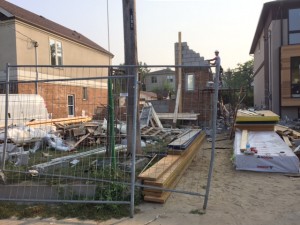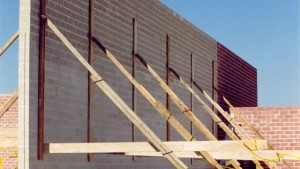
By by Robert Koci & Steve Payne
Editorial face-off: The walls came tumbling down
Canadian ContractorPublisher Rob Koci and Editor Steve Payne give their perspectives on a catastrophic wall failure last week in Toronto
Read: Not Again! Toronto house collapses under construction
“Was it this contractor’s fault?”
by Rob Koci
Publisher, Canadian Contractor magazine
In early September, I met with a contractor putting a second storey on a bungalow he owned in Toronto. The day before, his two exterior brick and block sidewalls on the original first storey came crashing down while his framers were setting up the joists for the second floor. Thankfully, there were no injuries.

An original brick wall of the bungalow reveals another course of cement block added on top. (photo: Robert Koci)
After realizing I was not there to destroy his reputation, the contractor invited me for a drive to look at other renovations in the area. “Look, these guys are doing the same thing I was doing,” he said as I took pictures of original, 14-foot high, brick and block walls capped with an additional four to six courses of new 10-inch block. There was absolutely nothing supporting them. No bracing, nothing. “Why did this happen to me? My walls were just like these. I did everything right. Why me?”
I then had a conversation with contractor and renovation consultant Reiner Hoyer (www.the-reno-coach.com), who reminded me of Toronto’s bylaws on second-storey additions.
Toronto bylaws – as in many cities – define the limit of a renovation by the amount of house still standing after demolition. Take down more than 50 per cent of the exterior walls and it’s deemed a new build. A new build means a lot more regulations and thousands of extra dollars out of the contractor’s pocket. Keep two of the original walls and the project is still a renovation.
Some of those original walls the contractor showed were in terrible shape: 80 years old, disintegrating mortar, huge voids, careless installation and inferior quality ceramic blocks. It was clearly just a matter of time before one of these structures came down.
Was it this contractor’s fault? He took a chance. He could have looked at the walls once they were exposed and said to himself, “Gee, these walls are unstable. I better void my reno permit, take them down, stop everything, apply for a new-build permit and spend another $25,000 and six months on this project.
Yea, he could have. Would you have?
Related: The Swiss cheese theory of site safety decision-making
Related: Could this House of Cards been averted?
“Don’t blame the bylaws”
by Steve Payne
Editor, Canadian Contractor magazine
Here at Canadian Contractor, we take a consistent editorial line against regulatory bodies who make it harder for even the most rigorously professional contractors to earn a living.

Building codes are not specific about bracing or reinforcement of original walls during a ‘renovation’, but are quite clear about new ones
We consistently lament that our contractor readers often face permit delays of months and months, obscene Workers’ Comp rates to fund crazy salaries to fat-cat pension civil servants and cash grabs like the Ontario College of Trades. We believe that the renovation and homebuilding industries are already well-regulated legally and via the building codes – and we just hate it when governments try to ram through new levels of red tape where we ought to be cutting the red tape we already have.
But Rob comes perilously close to blaming City of Toronto bylaws, across the page, for a recent house-under-construction collapse in East York. He says that a contractor took shortcuts to avoid “a lot more regulations and thousands of dollars” out of his pocket on a second-storey addition. Then he asks, wouldn’t many other contractors make the same decision?
All I can say is, we wouldn’t even be discussing bylaws that allow existing walls to be maintained to qualify a second storey addition as a “renovation” if someone had died in that implosion. The Weber barbecue on the neighbour’s driveway looked like crushed tinfoil. That could have been a baby stroller. The contractor could have killed some of his crew.
What’s wrong with reinforcing existing first storey concrete block walls with rebar and pumping concrete into them? What’s wrong with the basic principle of shoring up freestanding brick and block walls while they are being connected to? Money is what’s wrong with it? Time?
Even regulation-averse, free-enterprise-loving Canadian Contractor can’t even ask the question. Everyone needs to smarten up.
Advertisement
Print this page

Steve hit the nail on the head… as a contractor, I wonder how does someone leave a masonry wall that size, new or old unsupported while adding structure on and above it.? Is this guy really a “contractor”? I’d say not.
Rob makes the comment: “while his framers were setting up the joists for the second floor.” Sounds like they were standing and leaning those floor joists up against the wall…?
Also, enlarging the project pic shows that the site set-up and housekeeping is a joke. Plus, what exactly is that single 2×6 front support brace designed to do? Ah… act as plumb line? 😛
It’s a bad apple like this that spoils the basket for all legit contractors.
Great comment Steve. The industry in some ways is over regulated and we don’t need more. Yet we do need better work safety practices, as this was a near miss and people could have been injured. Workers and the public.
Great coverage on this incident from the team at Canadian Contractor. It brings awareness and hope it brings change.
Comment to Rob’s article: The tour you took in the area with the builder, turned up many other mishaps, maybe waiting to happen. The question is, why did no one see this before hand. I thought building inspections would have caught this issue and help guide the builders.
Its sure a wake up call. Thanks for your article Rob. Hope it brings change.
Seems to me that perhaps the contractor did not know something here about building standards and what works/doesn’t work. Many people in various situations have done the same, not always building related. there was a time when drinking and driving was OK or seatbelts were not required. I remember as a kid riding in the back window sill of my dads car. Unfortunately this turned out to be a bad judgement call. He was doing what is right in terms of building code but it becomes one of these gray areas. Thanks goodness no one was hurt or died. Bet the contractor has had a few bad nights since this happened.
The original brick walls were not crumbling, they were in great shape. You can’t take the front and back off a house and expect the sides to continue standing – that’s laughable! This was no accident, this was negligence (if not just shear ignorance). He was lucky that no one was killed. You would think that a house collapse would rattle a person, yet the site has been worked on since the incident! Even with a stop work order pending and in place. Evidently there is no regard safety – that of the trades/employees and that of the general public. This is what gives “the contractor” a bad reputation! No respect for safety and no respect for future owners and their families. It is shear greed. And with multiple projects currently under construction and already completed; he is destroying an entire neighborhood. What do you think his houses are going to look like in 10 years?
This “contractor” presents a very good argument for proper certification and training of real contractors. Given his demonstrated disregard for laws, safety and physics, I doubt he could attain such certification.
Paul Ledaire, B.Arch., AAA Architect (Ret’d), CSC